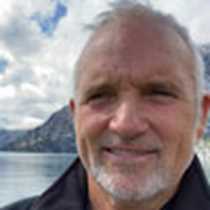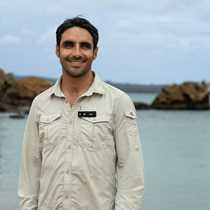At 6:00 a.m., we approached Margerie Glacier in Glacier Bay National Park. What a wakeup call! We reached this point about six hours after entering the park near Bartlett Cove, sixty-five miles south. This same distance took the Grand Pacific Glacier approximately 225 years to cover as it retreated and opened up the main fjord and our route within the park. We know this fact due to careful mapping by George Vancouver who sailed into Icy Bay in 1794. From that location, he saw nothing but a wall of ice barring the way. Like many explorers of his day, Vancouver was searching for the Northwest Passage, a northerly route through America. It did not exist at that time due to the glaciers of the “Little Ice Age,” which closed all routes through at these high latitudes.
Our exploration focused on geology as we cruised the park’s upper reaches in the morning. We viewed the Margerie and Grand Pacific Glaciers first, and then we tucked in and around Jaw Point to view the Johns Hopkins and Gilman Glaciers. As if the glacial scenery wasn’t special enough, the bedrock geology here is truly stunning. We saw a glacial scoured and polished exposure of the Tarr Inlet suture zone, where tectonic plates collided and fused together during a collision of exotic terranes. It’s a view to make a geologist’s heart skip a beat! At least this geologist’s heart!
Our return down the bay after brunch was highlighted by numerous wildlife sightings, including humpback whales, rafts of sea otters, brown bears, mountain goats, Steller sea lions, puffins (tufted and horned), pigeon guillemots, surf scoters, bald eagles, and just about every other bird one could expect to see on a perfect day in a perfect place in Southeast Alaska. Our last stop was an hour walk around the forest at Bartlett Cove, the national park headquarters. Though brief, it allowed an opportunity for all to stretch their legs a bit after a full day on the ship. It also provided another opportunity to learn more about forest ecology and the evolution of this extraordinary landscape.









